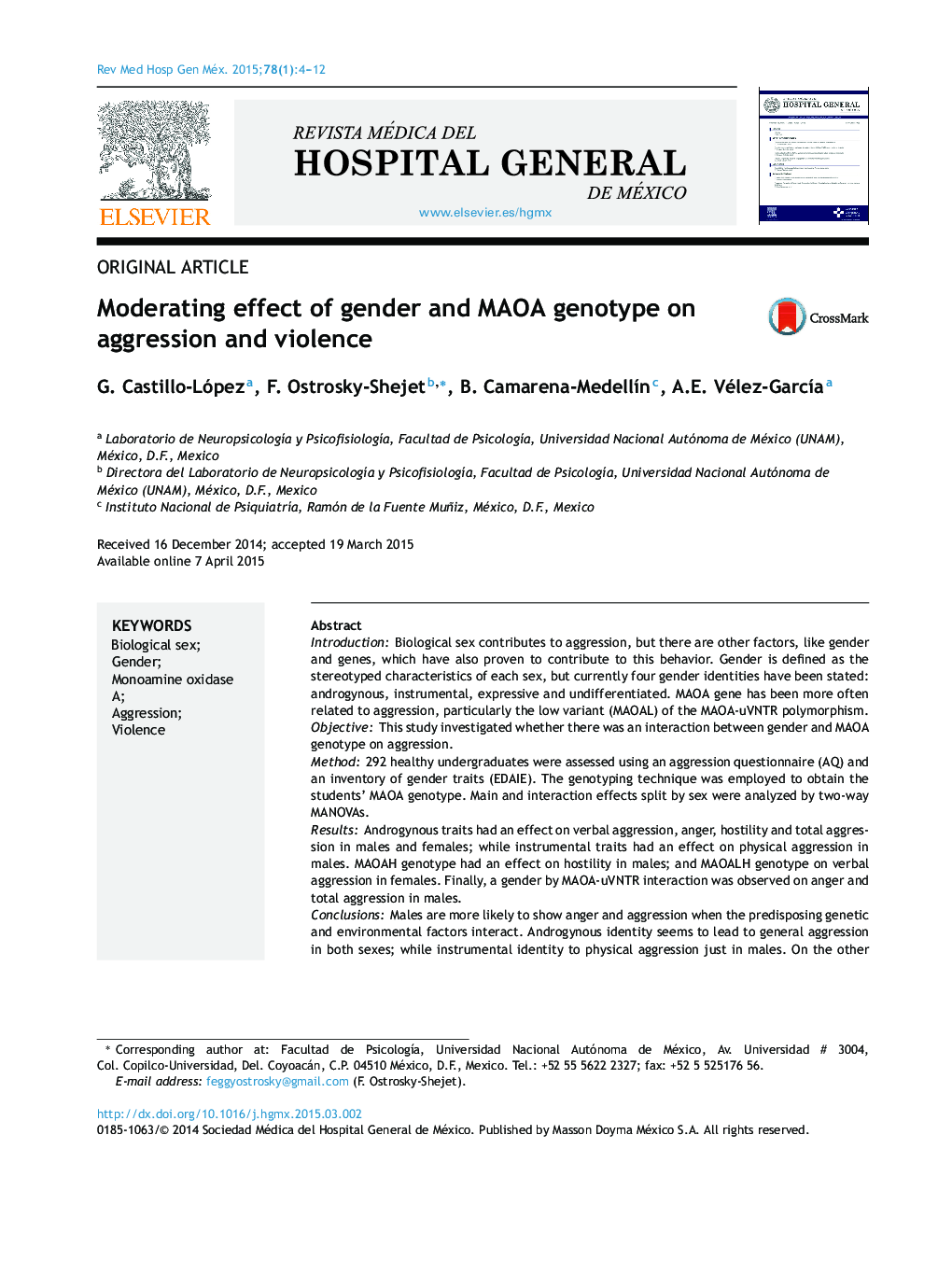| کد مقاله | کد نشریه | سال انتشار | مقاله انگلیسی | نسخه تمام متن |
|---|---|---|---|---|
| 3830917 | 1247195 | 2015 | 9 صفحه PDF | دانلود رایگان |

IntroductionBiological sex contributes to aggression, but there are other factors, like gender and genes, which have also proven to contribute to this behavior. Gender is defined as the stereotyped characteristics of each sex, but currently four gender identities have been stated: androgynous, instrumental, expressive and undifferentiated. MAOA gene has been more often related to aggression, particularly the low variant (MAOAL) of the MAOA-uVNTR polymorphism.ObjectiveThis study investigated whether there was an interaction between gender and MAOA genotype on aggression.Method292 healthy undergraduates were assessed using an aggression questionnaire (AQ) and an inventory of gender traits (EDAIE). The genotyping technique was employed to obtain the students’ MAOA genotype. Main and interaction effects split by sex were analyzed by two-way MANOVAs.ResultsAndrogynous traits had an effect on verbal aggression, anger, hostility and total aggression in males and females; while instrumental traits had an effect on physical aggression in males. MAOAH genotype had an effect on hostility in males; and MAOALH genotype on verbal aggression in females. Finally, a gender by MAOA-uVNTR interaction was observed on anger and total aggression in males.ConclusionsMales are more likely to show anger and aggression when the predisposing genetic and environmental factors interact. Androgynous identity seems to lead to general aggression in both sexes; while instrumental identity to physical aggression just in males. On the other hand, undifferentiated identity apparently leads to less aggression. These findings shed light on factors that could be initial indicators for future violent behavior.
ResumenIntroducciónEl sexo biológico contribuye a la agresión, pero existen otros factores, como el género y los genes, que también contribuyen a la misma. El género corresponde a las características estereotípicas de cada sexo, pero recientemente se han propuesto cuatro tipos: andrógino, instrumental, expresivo e indiferenciado. El gen de la MAOA es el que más se ha asociado a la agresión, particularmente la variante de baja actividad (MAOAL) del polimorfismo MAOA-uVNTR.ObjetivoInvestigar si existía una interacción entre el género y el genotipo MAOA sobre la agresión.MétodoSe evaluaron 292 universitarios sanos mediante un cuestionario de agresión (AQ) y un inventario de rasgos de género (EDAIE). Se usó la técnica de genotipificación para obtener el genotipo MAOA de los participantes y se analizaron los efectos principales y de interacción para cada sexo, mediante MANOVAs factoriales.ResultadosSe observó un efecto de los rasgos andróginos sobre la agresión verbal, el enojo, la hostilidad y el total de agresión en hombres y mujeres; y de los rasgos instrumentales sobre la agresión física en hombres. Se identificó un efecto del genotipo MAOAH sobre la hostilidad en hombres; y del genotipo MAOALH sobre la agresión verbal en mujeres. También se apreció un efecto de la interacción entre el género y el genotipo MAOA sobre el total de agresión y el enojo en hombres.ConclusionesLos hombres parecen ser más susceptibles al enojo y a la agresión cuando hay una interacción de factores genéticos y ambientales predisponentes. Los rasgos andróginos parecen predisponer a la agresión en ambos sexos; y los rasgos instrumentales sólo a la agresión física en hombres. En cambio, los rasgos indiferenciados aparentemente conducen a menor agresión. Tales hallazgos apuntan hacia factores que podrían ser indicadores de un comportamiento violento posterior.
Journal: Revista Médica Del Hospital General De México - Volume 78, Issue 1, January–March 2015, Pages 4–12